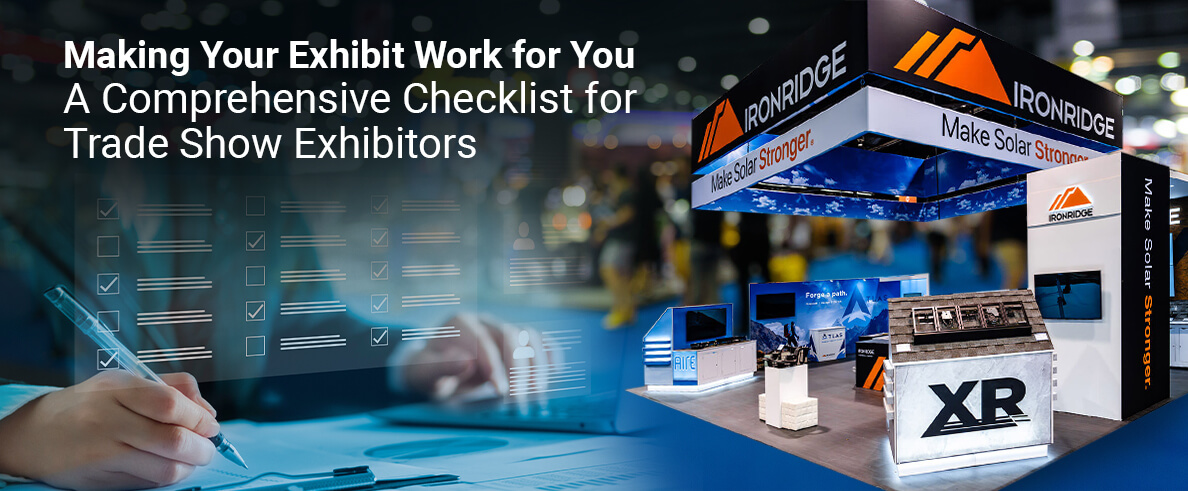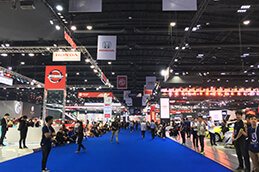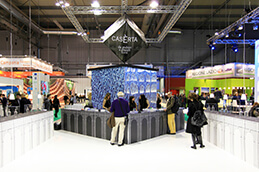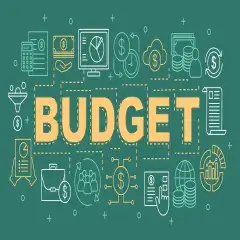
Making Your Exhibit Work for You: A Comprehensive Checklist for Trade Show Exhibitors
Marketing comes in numerous forms these days with more outlets available now than ever before. While the online world offers countless opportunities in this regard, the offline end of the spectrum continues to be an incredibly valuable source of new business. Ongoing studies show there’s still no substitute for old-fashioned person-to-person contact. Trade show checklists can help exhibitors navigate these in-person events efficiently by ensuring all critical tasks are completed before, during, and after the show.
Though billboards, mailers, charitable donations, and promotional giveaways can help generate brand awareness and spark new business relationships, few alternatives are quite as effective as trade shows and conventions. Incorporating these trade show checklists ensures that every aspect, from booth setup to follow-up procedures, is covered, leading to a more productive experience.
More than 90 percent of attendees come to these events in search of new products and service providers, placing exhibits among the most fruitful means of networking and generating leads. Using trade show checklists can optimize this process, helping exhibitors focus on tasks that maximize lead generation and networking potential.
Making The Most Of A Convention Exhibit
 Although the benefits of exhibiting at trade shows aren’t in question, making the most of these investments does bring up its fair share of uncertainties. Comprehensive trade show checklists can alleviate many of these concerns by keeping exhibitors organized and on track, ensuring nothing is overlooked.
Although the benefits of exhibiting at trade shows aren’t in question, making the most of these investments does bring up its fair share of uncertainties. Comprehensive trade show checklists can alleviate many of these concerns by keeping exhibitors organized and on track, ensuring nothing is overlooked.
Quite a bit of thought and planning must go into each stage of the process to truly capitalize on the experience. Trade show checklists act as valuable tools in guiding exhibitors through these stages, ensuring they don’t miss any key steps during the planning and execution phases.
Developing A Plan Of Attack
Before diving into any other element of your exhibit, it’s important to lay out your primary reasons for making an appearance. Obviously, drawing in new prospects to expand your clientele is part of the plan, but are other objectives at work here as well? Utilizing trade show checklists ensures that each of these objectives is accounted for and addressed properly.
checklists ensures that each of these objectives is accounted for and addressed properly.
Some common goals for businesses include:
- Expanding into new markets
- Launching new products or services
- Attracting fresh talent
- Reinforcing relationships with existing customers
- Sizing up the competition
Each goal has a distinct set of requirements. Having a Trade show checklist alongside makes it easier to align these goals with your strategy and ensure nothing is missed. Be sure to address the applicable ones from the beginning and incorporate them into your overall approach.
 Narrow Down The Options
Narrow Down The Options
All too often, businesses forge ahead hoping to accomplish the full range of prospective goals. For most, this type of strategy ends in disappointment. A well-structured trade show checklists can help businesses avoid this pitfall by narrowing their focus to the most crucial objectives.
Narrow down those targets to the most crucial ones and make them your focal points. One effective way of doing so is by looking at your business’ interior goals. Concentrate on trade show objectives that support those of the company as a whole.
Set A Budget
With all the possibilities unfolding before you and all the potential goals to address, it would be easy to spend a fortune on a single exhibit. Unfortunately, doing so might greatly hamper your ROI as well as the future growth of the company. A solid trade show checklists can assist in budget planning, ensuring you allocate resources wisely and avoid overspending.
Create a definitive budget and stick to it to avoid overspending. You might be surprised at how far even a minimal outlay will go but be sure the budget covers all the necessities like booth rental, display design, construction, and logistics. Trade show checklists also help track expenses and ensure no cost is overlooked.
 Know Your Audience
Know Your Audience
No doubt, you already have a target audience and customer persona in mind. These should expand beyond your everyday marketing and advertising methods and venture well into your exhibit. With the help of trade show checklists, you can tailor your booth design and marketing efforts to better meet your audience’s needs.
If you typically concentrate on the B2C realm, consider researching the expectations of vendors catering to your target audience to expand your horizons a bit. Trade show checklists can include steps for gathering this valuable information and applying it to your strategy.
Choose The Right Trade Shows
 As is the case with social media marketing, making appearances where your target crowds are likely to see you is imperative. Consider your niche, any markets you may want to expand into, and which shows fall in line with these elements.
As is the case with social media marketing, making appearances where your target crowds are likely to see you is imperative. Consider your niche, any markets you may want to expand into, and which shows fall in line with these elements.
These aspects will help you bring in more qualified leads and better fulfill your objectives on a number of different levels. Including the right shows in your trade show checklists will ensure you maximize your return on investment and connect with the right audience.
Pick A Plot

For most companies, securing a space takes up the most sizable portion of the trade show budget. This means finding the most effective piece of real estate for money is crucial. Including booth selection and location in your trade show checklists can ensure that no detail is left to chance.
Having said that, several different types of booths are available, each one offering its own set of benefits and disadvantages. Your trade show checklists should guide you through the booth selection process, weighing the pros and cons of each option based on your goals and budget.
Entering The Next Phase
 All those previous considerations will factor into your trade show booth design. Knowing who you’re marketing to and why as well as how much space you’ll have to work with and how much it’ll cost will come into play moving forward. Trade show checklists can help manage the design process, ensuring each element aligns with your objectives.
All those previous considerations will factor into your trade show booth design. Knowing who you’re marketing to and why as well as how much space you’ll have to work with and how much it’ll cost will come into play moving forward. Trade show checklists can help manage the design process, ensuring each element aligns with your objectives.
At this point, it’s time to begin thinking about the design, but first, you’ll need to decide how to go about acquiring the exhibit. Including design options and vendor coordination in your trade show checklists can keep the process organized and on track.
Is Purchasing Or Renting A Display The Better Option?
You have the choice to either purchase or rent an exhibit. Both options have certain advantages, but which one will benefit you most depends on your specific needs. Using trade show checklists can help you weigh the pros and cons of each option, ensuring your choice aligns with your overall objectives.
Pros And Cons Of Purchasing A Display
Purchasing a display means it’s yours for the long haul, so it’ll always be on hand. This is helpful for those who make spur-of-the-moment appearances at trade shows and other affairs and is usually the less expensive route for businesses exhibiting at multiple events each year. A well-structured trade show checklist will ensure you keep track of maintenance, updates, and logistics for your display.
On the other hand, owning a display means finding space to store it when not in use and scheduling its transport to and from each event. Keep in mind, marketing campaigns change and exhibit goals may not be the same from one event to the next. Trade show checklists can help manage the updates required to keep your display in line with evolving goals.
Continual redesigns and ongoing maintenance come with display ownership. Purchasing a display may also lead to limitations in the types and sizes of booths that’ll work for you. By following trade show checklists, you can ensure that any limitations are factored into your event planning.
Benefits And Pitfalls Of Display Rental
Renting tends to be a more cost-effective alternative for companies only attending one or two events each year. It also helps circumvent the common storage, logistics, and maintenance issues. Trade show checklists can help manage the rental process, from selection to customization.
At the same time, display rental provides a great deal of flexibility in terms of booth choices and design updates. For those who attend numerous events each year, though, renting can prove to be a costly venture. Using trade show checklists, you can evaluate the financial implications of renting versus purchasing.
It’s also not a great solution for companies that make a habit of booking last-minute appearances because design, construction, and testing can take anywhere from a few weeks to a few months. Having trade show checklists will help you avoid last-minute pitfalls and ensure timely execution.
With either option, you’ll have a full team of experts at your disposal, and the benefit of knowledge and experience is invaluable. Trade show checklists can help coordinate your team and ensure that everyone knows their role in the setup and operation of the booth.
If you’re new to the trade show circuit, renting displays initially until you learn the ins and outs of exhibiting could be helpful. Transitioning to ownership, later on, is always an option. Following trade show checklists allows you to track your experiences and decide when the time is right to purchase a display.
Designing Your Display
After choosing whether to purchase or rent a display, the real fun begins. Virtually endless design opportunities are out there for the taking. Still, a wide range of details goes into this leg of the process. Using trade show checklists will help ensure every design element is addressed and aligned with your overall strategy.
Graphics
Bold, eye-catching graphics are a must for any company. These will attract attention and draw people in for a closer look. Trade show checklists can guide the selection of color schemes, fonts, and layout to create an impactful visual presentation.
Texture
From smooth surfaces and acrylic accents to an extensive lineup of different fabrics, plenty of textures can be incorporated into your design. Incorporating texture into your trade show checklists ensures this crucial element isn’t overlooked.
Lighting
Lighting isn’t just for making products and materials more visible. In fact, it has the power to affect people’s moods and heighten their interest in what your company has to offer. Trade show checklists can help ensure that lighting is strategically placed to enhance your booth’s appearance and draw in more visitors.
Consistency
Though using a wide range of colors to stand out in the crowd and make an impression on attendees is important, maintaining brand consistency is vital as well. Ensure consistency with your brand by including it in your trade show checklists to keep everything aligned.
Interactive Elements
Attendees expect to be fully immersed in the experience when they visit a trade show display. With all the technology now available, there’s no excuse for not rising to the challenge. Adding interactive elements like touchscreens to your trade show checklists will help keep visitors engaged and interested.
Negative Space
If you’re like most exhibitors, you’ll want to pack as much into a display as possible. While properly showcasing your products, services, and information is crucial, giving visitors too much to look at could send them into sensory overload. Leave enough negative space, and use trade show checklists to make sure your display layout doesn’t overwhelm the viewer.
Deeper Details
Prospects are no longer interested in just the products or services a business has to offer. They want to know about the company itself. Trade show checklists can help you ensure that you’ve included brand storytelling elements that resonate with visitors.
Salesforce Strength
Those who man your exhibit are as much a part of the picture as graphics, displays, lighting, and any other component to be incorporated. Pay special attention to the human element as it’s the one truly making the connections. Trade show checklists can assist with organizing training sessions to ensure your team is well-prepared.
Follow-Up Procedures
According to a number of marketing reports, 98 percent of prospects won’t make a purchase during the first contact. They require a little more persuasion even if they’re leaning toward your company over its competitors. Trade show checklists can ensure follow-up actions, like phone calls and personalized emails, are promptly handled.
All Things Considered
From the pre-planning phase to keeping in touch with leads after the fact, a long list of considerations goes into creating a successful trade show exhibit. Be sure to give each of these points due attention. Use trade show checklists to guide you every step of the way and track the leads generated by the event. Those all-powerful metrics give you insight into just how effective your efforts were and which elements could be improved upon next time around.

